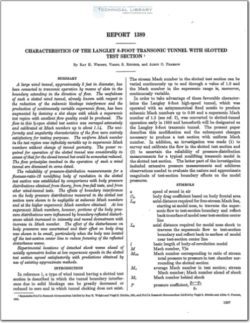NACA-Report-1389

- Version
- 159 Downloads
- 4.77 MB File Size
- 1 File Count
- December 4, 2015 Create Date
- December 4, 2015 Last Updated
National Advisory Committee for Aeronautics, Report - Characteristics of the Langley 8-Foot Transonic Tunnel with Slotted Test Section

A large wind tunnel, approximately 8 feet in diameter, has
been converted to transonic operation by means of slots in the
boundary extending in the direction of flow. The usefulness
of such a slotted wind tunnel, already known with respect to
the reduction of the subsonic blockage interference and the
production of continuously variable supersonic flows, has been
augmented by devising a slot shape with which a supersonic
test region with excellent flow quality could be produced. The
flow in this }6-open slotted test section was surveyed extensively
and calibrated at Mach numbers up to about 1.14. The uni—
formity and angularity characteristics of the flow were entirely
satisfactory for testing purposes. The uniform Mach number
in the test region was infinitely variable up to supersonic Mach
numbers without change of tunnel geometry. The power re—
quired for operation of the slotted tunnel was considerably in
excess of that for the closed tunnel but could be somewhat reduced.
The flow principles involved in the operation of such a wind
tunnel are discussed in some detail.
The reliability of pressure-distribution measurements for a
fineness-ratio-M nonlifting body of revolution in the slotted
test section was established by comparisons with body pressure
distributions obtained from theory, from free-fall tests, and from
other wind—tunnel tests. The ejects of boundary interference
on the body pressure distributions measured in the slotted test
section were shown to be negligible at subsonic Mach numbers
and at the higher supersonic Mach numbers obtained. At low
supersonic Mach numbers, however, portions of the body pres—
sure distributions were infiuenced by boundary-reflected disturb-
ances which increased in intensity and moved downstream with
increase in Mach number. The eject of the disturbances on
body pressures was ascertained and their eject on body drag
was shown to be small, particularly when the body was located
of the test-section center line to reduce focusing of the reflected
disturbance waves.
Erperimental locations of detached shock waves ahead of
axially symmetric bodies at low supersonic speeds in the slotted
test section agreed satisfactorily with predictions obtained by
use of existing approximate methods.
| File | Action |
|---|---|
| naca-report-1389.pdf | Download |
Comment On This Post